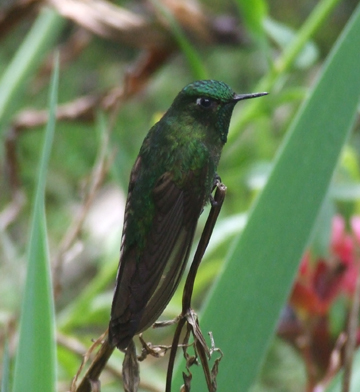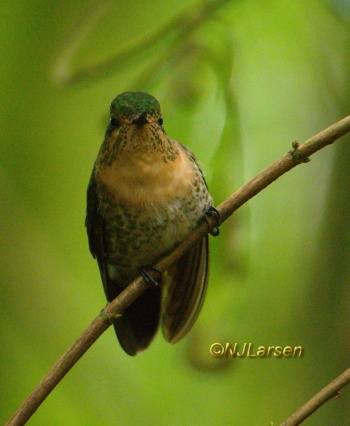(replace photo of female) |
|||
| Line 10: | Line 10: | ||
==Taxonomy== | ==Taxonomy== | ||
| − | [[Image: | + | [[Image:Tyrian_Metaltail_female_by_njlarsen.jpg|thumb|350px|right|Photo of female by {{user|njlarsen|njlarsen}}<br />Guango Lodge, Napo, [[Ecuador]], August 2015]] |
Seven subspecies are recognized<sup>[[#References|[1]]]</sup>: | Seven subspecies are recognized<sup>[[#References|[1]]]</sup>: | ||
*''M. t. districta'' | *''M. t. districta'' | ||
Revision as of 02:34, 2 April 2016
- Metallura tyrianthina
Identification
Less than 10 cm with straight bill 1 cm.
Male is mainly dark green with glittering green throat gorget and white postocular spot. The subspecies differ in tail coloration, from bronzy-green, bronzy-olive, coppery-red, to golden-red.
Female is slightly smaller than male, green above, buff to cinnamon underside, and with tail similar to male.
Distribution
Venezuela, Colombia, Ecuador, Peru, and Bolivia.
Taxonomy
Seven subspecies are recognized[1]:
- M. t. districta
- M. t. chloropogon
- M. t. oreopola
- M. t. tyrianthina
- M. t. quitensis
- M. t. septentrionalis
- M. t. smaragdinicollis
Habitat
Medium to very high elevation often in forest, edges or around clumps of trees in more open high elevation areas.
Behaviour
Usually defends a feeding area from other hummers, at low to middle height of trees. Often lands on flower to feed.
References
- Clements, JF. 2009. The Clements Checklist of Birds of the World. 6th ed., with updates to December 2009. Ithaca: Cornell Univ. Press. ISBN 978-0801445019.
- Restall et al. 2006. Birds of Northern South America. Yale University Press. ISBN 9780300124156





